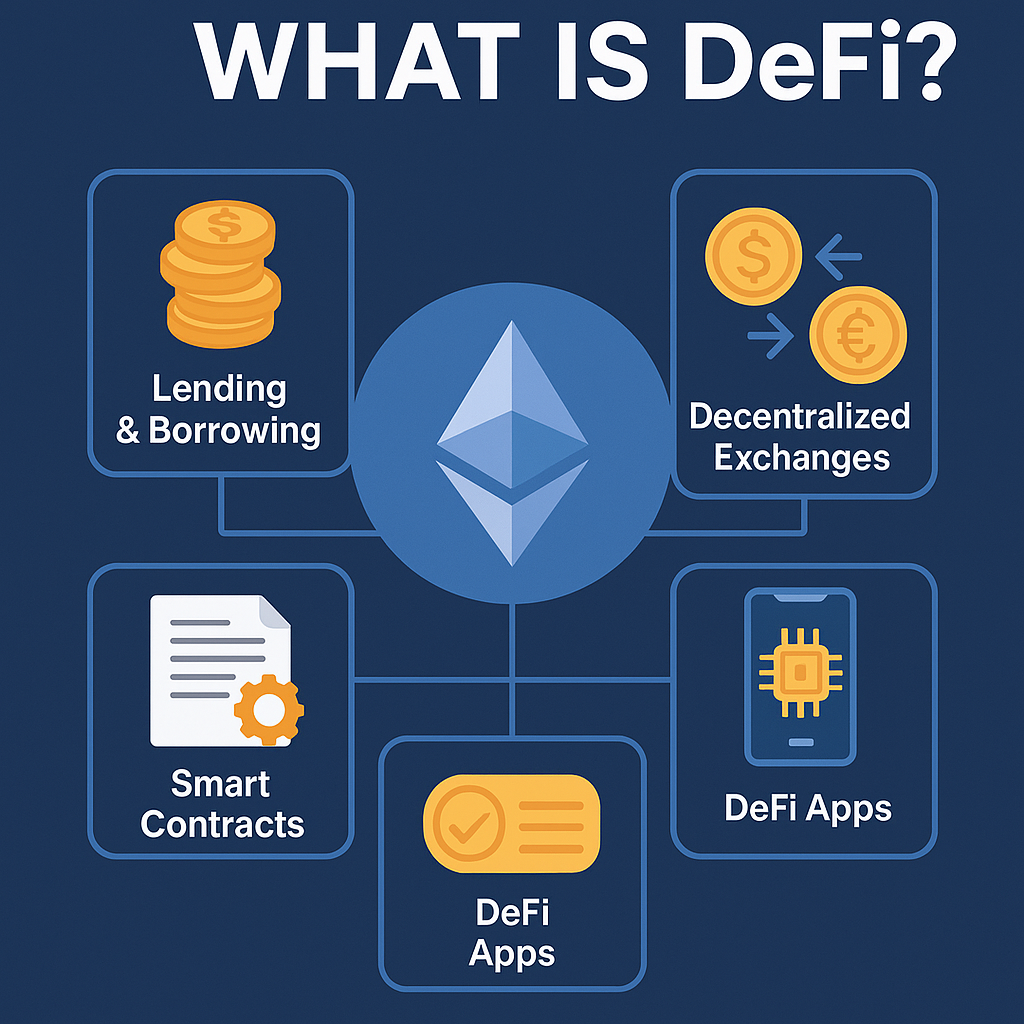🔑 What Is DeFi?
What is DeFi? You’ve probably seen this term everywhere if you’re curious about cryptocurrency. DeFi, short for Decentralized Finance, is all about creating a new kind of financial system — one that runs without banks, brokers, or middlemen. Instead, it relies on blockchain technology to let anyone in the world access financial services like lending, borrowing, trading, and saving. With DeFi, it’s just you, your crypto wallet, and smart contracts doing the work.
💡 Why Is DeFi Important?
👉 Financial freedom: Anyone can access DeFi with a wallet — no ID or approval required.
👉 Low fees: Without middlemen, DeFi often costs less than traditional banking.
👉 24/7 markets: DeFi apps work day and night, with no downtime.
👉 Innovative products: DeFi offers unique services like yield farming, staking, and synthetic assets.
🔍 Key Components of DeFi
💥 Smart Contracts
Self-executing programs that run on the blockchain, automating transactions without human involvement.
💥 dApps (Decentralized Applications)
Applications built on blockchains (mostly Ethereum) that provide DeFi services.
💥 Liquidity Pools
Funds locked in smart contracts that enable trading, lending, or borrowing in DeFi platforms.
💥 Stablecoins in DeFi
DeFi relies heavily on stablecoins like USDT, USDC, or DAI to reduce crypto volatility in trading and lending.
🛠️ Top Uses of DeFi
When we talk about what is DeFi used for, here are key examples:
✅ Decentralized lending & borrowing – Earn interest or get a loan using crypto as collateral.
✅ Decentralized exchanges (DEXs) – Swap tokens directly, peer to peer.
✅ Derivatives & synthetic assets – Get exposure to stocks, commodities, or fiat without actually holding them.
✅ Insurance protocols – Protect funds against smart contract failures (e.g., Nexus Mutual).
✅ Crowdfunding & DAOs – Raise funds and govern communities without centralized control.
🌐 DeFi Examples in Action
👉 Uniswap: Leading DEX for swapping ERC-20 tokens.
👉 Aave: Popular for crypto loans and deposits.
👉 MakerDAO: Generates the DAI stablecoin, a key tool in DeFi.
👉 Curve Finance: Specializes in low-slippage stablecoin trades.
👉 Synthetix: Offers synthetic asset trading.
⚡ DeFi Benefits
✅ Open access to financial services globally
✅ Control stays with the user, not third parties
✅ Transparent — all actions visible on-chain
✅ Faster settlement times
✅ Programmable, customizable financial tools
⚠️ DeFi Risks
❌ Complex for beginners — a learning curve exists
❌ Smart contract exploits can drain funds
❌ Volatile collateral can trigger liquidation
❌ Regulation uncertainty — rules are evolving
📝 DeFi vs CeFi vs TradFi
| Feature | DeFi | CeFi (Centralized Finance) | TradFi (Traditional Finance) |
|---|---|---|---|
| Custody | Self-custody | Company custody | Bank custody |
| Access | Open | Limited by platform | Limited by country |
| Fees | Low | Medium | High |
| Control | User | Company | Bank/regulator |
| Transparency | Full | Partial | Low |
🚀 How To Get Started with DeFi
1️⃣ Set up a wallet (e.g., MetaMask, Trust Wallet)
2️⃣ Buy ETH or another base coin
3️⃣ Connect to a DeFi app
4️⃣ Start small — experiment with swaps, lending, or staking
💬 Why Knowing What Is DeFi Matters
Understanding what is DeFi is the first step toward participating in a truly open financial system. DeFi lets anyone, anywhere, take control of their assets and access advanced financial tools. But as with all crypto, it’s vital to research, start small, and manage risks carefully.
🔗 Internal Links
🌐 External Resources Links
💬 Final Thoughts: The Future of DeFi
Now that you know what is DeFi, it’s clear that decentralized finance isn’t just a trend — it’s a movement reshaping how the world thinks about money. Whether you’re looking to earn interest on your crypto, trade without an exchange, or just understand this emerging space, DeFi offers incredible opportunities.
⚠️ Remember: DeFi comes with risks, so always research, start small, and learn as you go. The decentralized future of finance is here — and it’s open to anyone ready to explore it.

